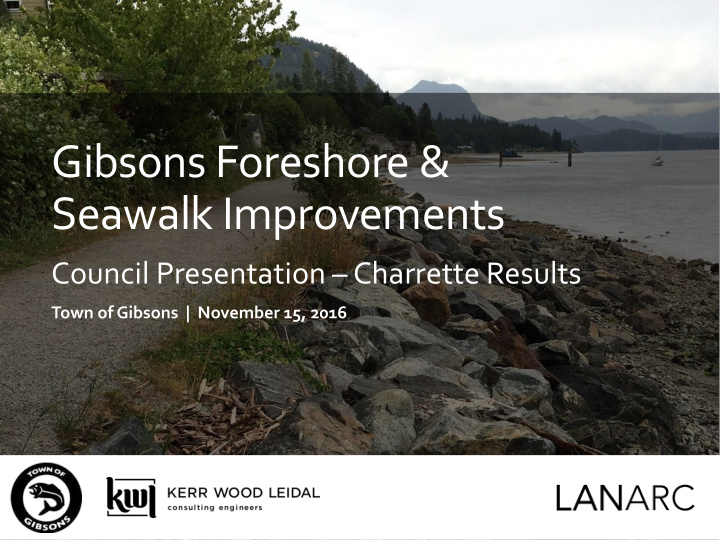



Gibsons Foreshore & Seawalk Improvements Council Presentation – Charrette Results Town of Gibsons | November 15, 2016
Agenda 2 1. Study Area & Design Constraints 2. Questionnaire Results 3. Charrette Results 4. Next Steps
Study Area 3
Design Constraints – Land Tenure/Use 4
Study Area 5 Foreshore “generally refers to the area between the natural boundary of the ocean and the lowest tides” Access Sewer Slope
Design Constraints/Challenges 6 • Sanitary sewer alignment is fixed in access road; may require replacement • Land Area/width is very limited from properties to ocean—very tight lateral space and this limits available options • Riprap (angular rock) protecting sewer/seawalk is in poor condition, not aesthetically appealing and needs rebuilding • Beach slope and size of material (i.e. sand, gravel, cobble, angular rock) are critical design constraints • Climate change risks (e.g. sea level rise and possible storm- surge increase • Protecting Eelgrass is important and is expanding toward the nearshore area – considered critical habitat
Questionnaire Results 7 • Public invited to describe their use and priorities for foreshore area through a survey distributed in print/online • Received 47 responses between Jun 16 – Jul 29 Development Opportunities: Most frequent • Keep foreshore natural with low density development uses of foreshore • Some want small-scale businesses/restaurants along include: foreshore • Recreational / • Some want seawalk paved, others prefer gravel dog walking • bench sitting • swimming at Development Challenges: Armours Beach • Concerns about eelgrass protection • Sea level rise & flood/erosion from high tides • Limited stroller and wheelchair accessibility
Charrette Objectives & Agenda 8 Objectives • Review public input received • Share info on constraints & opportunities • Work creatively to explore all possible solutions • After discussion, integrate the best ideas into design concepts Agenda – Three Sessions Morning Session – Designers and Charrette Participants (Brainstorm design ideas to accommodate uses and constraints) Afternoon Session – Designers (optional for charrette participants) (Produce a design concept for the Foreshore reflecting Morning Session discussion) Evening Session – Public Open House (Small Group Discussion; Presented Results from earlier sessions)
Sea Level Rise (SLR) Global SLR – gradual increase to high tide 0.5m by 2050, 1.0m by 2100, continues Shoreline dikes over 200 years? Natural boundary moves up/inland Buildings move up at point of reconstruction/ end of building life – maintain property values
Adapting to the Future Long Term Ideal (2050, 2100 or 2200?) Short Term Phased Improvements Now 2030 2050
BC SLR Guidelines 11
Storms and Sea Level Rise Flood Level Existing SLR 200 year 2100 High Tide 2.74 3.74 &Storm Surge Future Wave Effects 1.14 1.14 Character? Freeboard 0.6 0.6 FCL 4.5 5.5 High tide 2.1 m HHWLT -1.8 m Average Low tide
Future Character? Future Character? More natural tree/shrub backshore or More gentle built shoreline?
Design Criteria/features Questions we pondered? Design Criteria What design life? 25, 50, 100 years? • Eco Asset What flood level do we chose? • Habitat protection What elevation for walkway/service road? Habitat benches and natural features? • Riparian Future Access points? Walkway width? Service enhancement Characte? road width? • Aesthetics and How do we adapt to today but plan for future Recreation when some buildings are too low now? • Stability What about filling on private land? • Constructability • Cost 3.5 m trail crest intermediate elevation? (2.8 m existing) 4.5 m wide travel lane including 1 m green space Habitat benches in key areas Viewing points
Design Charrette Outcomes 15 Outcomes from Morning/Afternoon Sessions Public Area Upgrade and Enhance Slope Enhance Beach Area
Typical Concept – Short Term 16 Raise walkway Upgrade riprap
Typical Concept – Long Term 17
Armours Beach Concept – Short Term 18 Raise walk Sand Fill
Armours Beach Concept – Long Term 19
Highlights from Morning/Afternoon Sessions 20 • Enhance foreshore “Green Shores” where possible • Protect Eelgrass area & spawn areas • Increase natural vegetation between walkway & water; soften shoreline (where possible) • Improve Armours Beach Area ( more sand , swimming and amenities) but concern about Eelgrass
Highlights from Morning/Afternoon Sessions 21 • Provide a better visitor experience (parking, trails, wayfinding, flow, public art) • Improve public access from Grandma’s Pub end • Increased access for mobility challenges (Funicular rail?) • Provide recreation around docks for a range of ages • Improve educational opportunities • Connect history and “The Beachcomers” angle for tourism
Design Charrette Outcomes 22 Implication for Concept Design: Three Focus Areas 1. Armours Beach: • Top priority area identified by community for beach access and recreation • Preference for sandy beach for improved swim experience 2. Centre Seawalk Area: • Modify slope to be greener and decrease slope where possible • Provide intermittent access points from walkway down to beach • Provide seating/rest spots at regular intervals adjacent to walkway 3. South Seawalk & Wharf: • Improve connection from Wharf to Seawalk with wider public art area and wayfinding signage etc.
Design Charrette Outcomes 23 Public Area Upgrade and Enhance Slope Enhance Beach Area
Design Challenges to Overcome 24 Environment vs Public Safety vs Property Rights 1. What elevation should we rebuild at the walkway to allow for future protection, while enhancing the eco asset but consider property owners and access? 2. What year should the design horizon be? Should the flood risk vs future land use be identified and steps be taken for a change in land use in the future, i.e. convert private land into park/recreation amenity? 3. How should work be phased since capital cost may be a challenge?
Next Steps 25 November December October Refine & Cost Prepare Report Charrette Final Concept
Recommend
More recommend